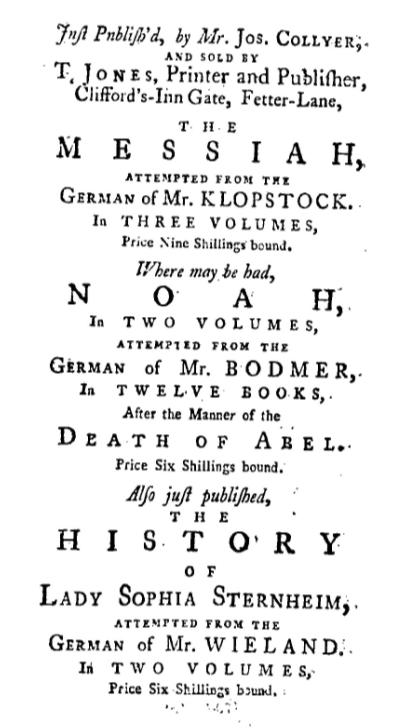Want to go down a fun C18 #HerBook rabbit hole with me through England and Germany and back again?! Buckle up!!!
A ....
....
1/
#BookHistory #FeministBibliography #C18
A
 ....
.... 1/
#BookHistory #FeministBibliography #C18
This book was owned by Margaret Anne Dewes and was a gift from her aunt, E. Eldridge in 1776. The text itself (more next post) is a translation of a Swiss author's epic poem into English by Mary Collyer. Some info about her here: https://en.wikipedia.org/wiki/Mary_Collyer
2/
2/
The Death of Abel (Der Tod des Abels), is an epic poem written by Swiss author Salomon Gessner and trans. into English by Mary Collyer. This particular printing is the 11th edition from 1776, but Collyer was the translator for most of the English editions, starting in 1761.
3/
3/
Quick digression about Gessner! He lived in Zürich and did quite a few things there, including writing poetry. He was one of the first German poets to receive international fame. Gessner's father, Hans Konrad Gessner, was a highly influential bookseller, publisher, & printer.
4/
4/
Just like the Gessners were right at the heart of the book trade, so too were the Collyers. Mary Collyer's husband, Joseph Collyer Sr, was a publisher and translator. Their son, Joseph Collyer Jr, was an engraver, who eventually became the portrait engraver to Queen Charlotte
5/
5/
Mary Collyer dedicates her translation of the text to Queen Charlotte, her patron, emphasizing the German connection between Gessner's original poem and Queen Charlotte's "Native Language" of German (two excerpts here-- the full dedication is eight pages)
6/
6/
At the end of the Gessner translation, an advertisement for three other works also published by Joseph Collyer (Mary's husband) is given. For all three of these works, Joseph Collyer was also the translator from German.
7/
7/
The works listed are English translations of 1) Noah by Johann Jakob Bodmer 2) Der Messias by Friedrich Gottlieb Klopstock and 3) Die Geschichte des Fräuleins von Sternheim by Christoph Martin Wieland.... except NOPE! Wieland isn't the author of DGdFvS! Sophie von La Roche is!
8/
8/
We're leaving Margaret Anne Dewes' copy of The Death of Abel now to talk about issues of authorship in the bibliography of Die Geschichte des Fräuleins von Sternheim in Germany & its English translation The History of Lady Sophia Sternheim
9/
9/
Die Geschichte des Fräuleins von Sternheim (1771) was written by Sophie von La Roche. It's the 1st novel published in German by a woman, and it is also the 1st "official" German epistolary novel (written in the style of Richardson). Goethe's Werther appears three years later.
10/
10/
To publish the novel, La Roche needed help from (her former fiancé) Christoph Martin Wieland, who was a well-respected German writer. The two read Richardson's novels together during their earlier courtship/engagement, so she knew Wieland would support her epistolary novel.
11/
11/
In an attempt to protect La Roche from criticism, and to more easily persuade German publishers/printers to produce it, Wieland chose to issue a preface that pretended La Roche wrote the novel as a hobby & that it was Wieland who wanted it published, not La Roche.
12/
12/
His preface is written as a letter to La Roche, telling her not to panic when she discovers her novel has been published without her knowledge (this is false), while also defending it to readers as an exceptionally moral, beautiful novel that HAD to be published.
13/
13/
I could say a lot about the misogyny of Wieland's preface, as well as his comments/corrections to La Roche's manuscript & his frequent, completely pointless footnotes throughout the novel... but that will take me way off topic. Let's talk about La Roche's authorship.
14/
14/
The title page makes no mention of La Roche as the author, only notes that Wieland is the editor. Similarly, his preface (which is addressed to her) only addresses her through an acronym of her titled name: D. F. G. R. V. ******* (die Frau Geheime Rätin Von La Roche)
15/
15/
Either some reviewers missed the preface, thought it was a lie, or just didn't care. A review in the Göttingische Anzeigen von gelehrten Sachen credits Wieland as the author of the novel, and actually praises him for the characters and writing throughout the review.
16/
16/
I love this particular copy of the review because at some point an owner (whether reader, librarian, bibliographer, or someone else) crossed out Wieland's name and wrote "by Madame von La Roche" in the margins. Yes! Reclaim women's writing! Looks like C18 hand to me, but 
17/

17/
Now back to J. Collyer's English translation of La Roche's. The is the title page to the edition advertised in The Death of Abel I discussed earlier, and it explicitly lists Wieland as the author.
18/
18/
Collyer's translator's preface is dizzying. He acknowledges and praises La Roche as the author in the beginning, yet also heaps a load of praise on Wieland. If he knew La Roche was the author, why did he allow the printers to continually attribute authorship to Wieland?
19/
19/
This error of authorship was never corrected in C18 editions of the novel in English. In a 1786 catalogue of books, Collyer's translation notes Wieland as the author and another, later English translation by Edward Harwood also credits Wieland
20/
20/
Anyways- I want to underscore how this bibliographic journey highlights both the visibility of women in the C18 'book world', while also showing how easy it was for them to be left out & stripped of credit. We started with Margaret Anne Dewes' #HerBook, a gift from her aunt. fin!

 Read on Twitter
Read on Twitter



























